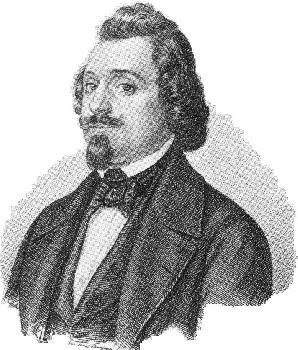Raffaele Mirate
His first tenor appearance came in 1833, again as a choir soloist. In 1834, he appeared in opera for the first time, in a student
performance at the conservatory. At age 21, he left San Pietro a Majella, and continued his vocal studies with a private teacher.
His professional debut followed in 1837 at the Teatro Nuovo in Naples, in Donizetti's Torquato Tasso; the following year, he was
already at the (larger) Teatro San Carlo, where he made his debut as Rodrigo in Rossini's Otello.
In 1839, he was back to the Teatro Nuovo, then he followed the advice of the famous tenor Luigi Lablache and joined him to Paris, where
the Théâtre des Italiens was looking for a new first tenor. Mirate was accepted, and now his career really took off. He
stayed at the Théâtre des Italiens for three years, but made guest appearances at La Scala and in Belgium during his tenure.
In 1843, he was at the Teatro Carignano in Torino, in winter 1843/44 in Trieste, in 1844 in Modena and Lugo, in 1845 in Rome (Teatro
Argentina). In 1847, he sang both in concert and in opera in Vienna, then he appeared in Bergamo and Venice. The Carnival season 1848
found him at La Scala. In 1849, he sang a long season in Genova at the Carlo Felice, where he returned the following year, as well as to
La Fenice. In 1851, he was at La Fenice again and sang Duca in the world premiere of Rigoletto, then he spent the rest of the year
between Modena, Verona and Vicenza. In 1852, it was Verona's turn again, plus he appeared in Padova and returned to Naples. In 1853 and
1854, he split his time between Venice, Vienna, Trieste, Udine, Treviso and La Scala, at which latter theater he stayed well into 1855.
Then he embarked on an American tour that led him to New York City and Boston. In winter 1855/56, he appeared at the San Carlo in Naples,
then he returned to Vienna, Vicenza and Bologna. In 1857, he was in Palermo and Bologna, in 1858 in Torino, in 1859 in Lisbon. In 1860,
he toured South America (Rio de Janeiro, Montevideo, Buenos Aires). In spring 1861, he sang Riccardo in Modena, and then he decided to
retire. He moved back to Naples, where he gave a handful of infrequent performances at the San Carlo before leaving the stage definitely
in 1866: his voice that had used to be so very robust had now rapidly deteriorated. In the course of his career, he had sung 2628
performances (roughly 100 per year), and 403 of them in novelties in whose world premieres he had participated. Donizetti and Verdi roles
were considered his best achievements (Aroldo was another of his world premieres), but he sang of course works by many other
composers, too: Mercadante, Bellini, Rossini, Petrella, Federico Ricci, Pacini, Peri, Nicolai, Meyerbeer, Flotow, Rossi, Balfe, to name
but a few.
Reference: Treccani, Dizionario Biografico degli Italiani, vol. 75, Roma 2011
|
